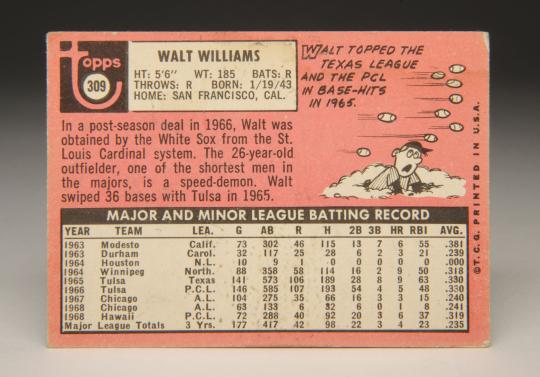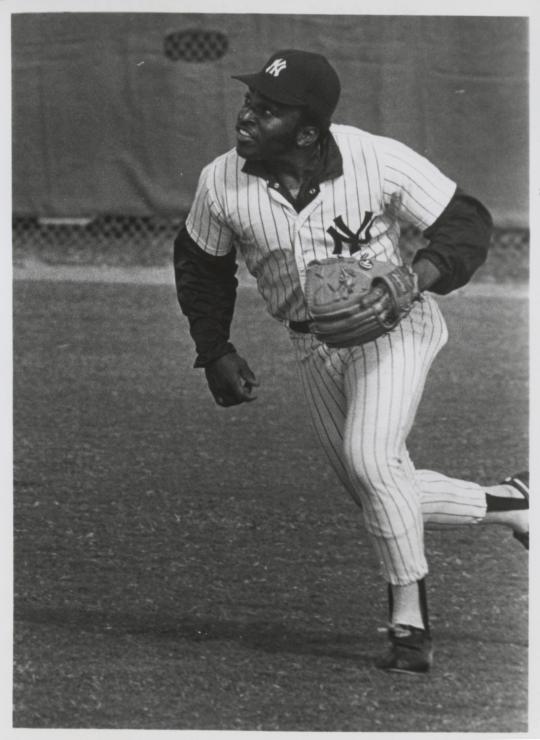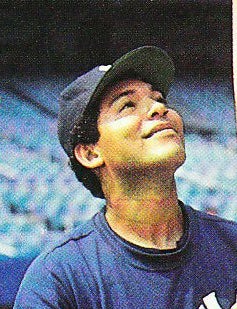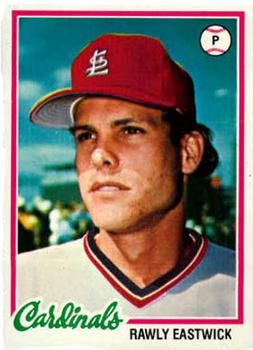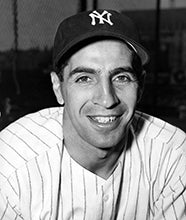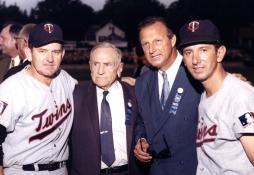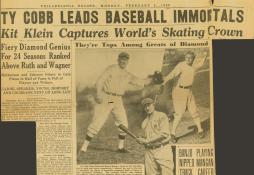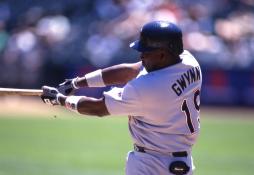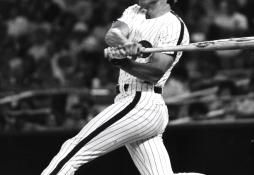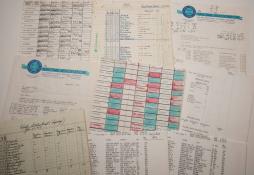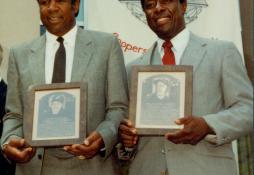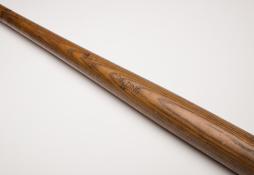- Home
- Our Stories
- #CardCorner: 1969 Topps Walt Williams
#CardCorner: 1969 Topps Walt Williams
Hall of Fame staffers are also baseball fans and love to share their stories. Here is a fan's perspective from Cooperstown.
Walt Williams was one of the most distinctive looking ballplayers of his era. Built strong and low to the ground, Williams’ physique could best be described as that of a fireplug. He was only five feet, six inches tall, but had the kind of broad shoulders and thin waist that we tend to associate with great athletes. Except those athletes tend to be bruising fullbacks in football, rather than speedy outfielders in baseball.
And then there was that neck, or lack thereof. As can be seen on his 1969 Topps card, Williams had one of the shortest necks around, so short in fact that he earned the nickname of “No Neck.” So it is with some irony that we should note that Williams is wearing a turtleneck shirt under his powder blue Chicago White Sox road uniform. Why would a player nicknamed No Neck need a turtleneck? That will have to remain one of the game’s great mysteries.
Williams had an effect on popular culture, with his name sometimes becoming the punch line to jokes and amusing stories. When I first became interested in weightlifting in 1970s, my father admonished me, offering a cautionary tale. He told me repeatedly, “Don’t overdo it lifting those weights. You’ll end up looking like No-Neck Williams!”
Williams earned that memorable nickname during his first major league stint. Signed by the Houston organization in the early 1960s, when the franchise was still known as the Colt .45s and not the Astros, Williams made his major league debut in 1964. It didn’t take long for his teammates to take note of his unusual physique. Williams’ height, which was just about the same as Hall of Famer Phil Rizzuto, seemed more appropriate for that of a second baseman or a shortstop. As outfielders go, he was unusually diminutive. But he also weighed 190 pounds and was so extraordinarily well developed in the chest, with muscles in his upper torso seemingly obscuring the length of his neck. Colorful Colt .45s catcher John Bateman observed Williams for only a short time before dubbing him "No Neck."
At first, Williams bristled at the nickname, but he grew to accept it. As he once told famed sportswriter Jimmy Cannon, “They can call me anything, as long as I’m in the big leagues.”
After Williams appeared in only 10 games for Houston, the Colts tried to sneak him through waivers. The effort failed. The St. Louis Cardinals snapped him up, but immediately demoted him to the minors. Williams would never appear in a game for the Cardinals. After the 1966 season, the Cards sent him packing to the White Sox as part of a deal for veteran catcher Johnny Romano. It was with the White Sox that No Neck would find his niche.
Displaying outfield skills that belied his blocky, bulky appearance, Williams overcame a weak arm and became an adept fielder, best suited for either left field or right field, but with enough speed to merit time as a center fielder. He played his first two seasons as a utility outfielder, filling in for veterans like Ken Berry and Pete Ward. He didn’t hit much, instead contributing with his speed and energy.
In his third season, the free-swinging Williams began to have an impact, emerging as the White Sox’s everyday right fielder. Thought not a particularly powerful hitter, he rarely struck out and used his contact-hitting skills to bat .304 in 1969, putting him in the top five in the American League batting race. Williams was one of only six players in the league to bat higher than .300, along with Hall of Famers Rod Carew and Frank Robinson, and notables like Tony Oliva, Boog Powell, and Reggie Smith.
Almost as importantly, Williams became a cult figure and fan favorite at Comiskey Park. Always smiling and seemingly thrilled to be playing at the major league level, Williams drew the favor of both the White Sox’s faithful and his teammates. They loved his upbeat attitude and his willingness to hustle, something that he had always prided himself on. (To this day, it would be difficult to find a White Sox fan who remembers Williams ever not hustling.) Williams had grown up so poor in the state of Texas that he had to pick cotton at the age of 10 - while earning $2.50 a day. Williams wanted no more of that lifestyle, so he hustled on every play.
Not surprisingly, more than a few Sox diehards reacted with anger in October of 1972 when the White Sox traded Williams to the Cleveland Indians for infielder Eddie Leon. The White Sox loved Williams’ personality, but his sporadic hitting - he had a good season in 1971, surrounded by off years in 1970 and ’72 - became a source of concern. The Sox also needed help at shortstop, a position that Williams could not play. Deeming him expendable, the Sox traded him for Leon, who could legitimately handle the position. All of those realities did little to console enraged members of the Williams fan club.
Williams batted .289 in his one year with the Indians, doing a good job as a fill-in outfielder and occasional DH. He became one of the better backup players in the American League, but the Indians couldn’t resist the opportunity to use him as part of the bait in a three-team spring training trade that brought veteran right-hander Jim Perry to Cleveland. The trade united Perry with his Hall of Fame brother, Gaylord Perry, while fitting No Neck for the pinstripes of the Yankees.
When he joined the Yankees, Williams received word that he would have to shave his mutton chop side burns, which had become one of his trademarks. In contrast to the Indians and White Sox, the Yankees forbade mutton chops, along with beards and long hair.
Not only did Williams make the Opening Day roster, but he also hit .281 and reached base 32 percent of the time. Somewhat surprisingly, the Yankees released him during the spring of 1976. The release essentially ended his big league career, while denying him an opportunity at postseason play, as the Yankees went on to win the Eastern Division and the American League pennant that summer and fall.
During his two-year sojourn in New York, which coincided with the Yankees’ brief tenure at Shea Stadium. Williams made some light-hearted news with his Ruthian appetite. Williams, first baseman-DH Ron Blomberg, and shortstop Gene Michael often made trips to the local branch of Burger King, downing multiple hamburgers at the price tag of 39 cents a burger. Williams ate hamburgers voraciously, in much the same way that “Wimpy” did in those old Popeye cartoons.
Williams had another interesting habit, as noted by Marty Appel in his wonderful book, "Now Pitching for the Yankees." Both before and after games, Williams liked to cover his body in Vaseline. Williams felt that it was good for his skin.
Williams was determined to keep playing. Only 31 years of age, he felt he had something to offer to the Japanese Leagues. So he signed a contract to play for the Nippon Ham Fighters. His teammates there included Masanori Murakami, who had become the first Japanese born player to appear in the major leagues in 1964. Williams played the outfield for Nippon Ham and showed never-before-seen power, hitting 23 home runs and slugging .466.
Williams played almost as well in 1977, this time hitting 21 home runs and stealing 10 bases. He also made 14 appearances at second base. Rather surprisingly, the Fighters chose not to bring Williams back for a third season, so he found another venue to play, this time in the Mexican League. That’s where Williams finished out his career in 1978 and ’79.
So there were no playoffs or World Series for Walt Williams. He just had to settle for 10 happy-go-lucky big league seasons filled with smiles and hamburgers. He also had little trouble adjusting to life after the major leagues. His wintertime work in the state of Ohio’s drug abuse program made for a good transition to his second career, working with youth in sports and recreation.
He passed away on Jan. 23, 2016.
Bruce Markusen is the manager of digital and outreach learning at the National Baseball Hall of Fame



